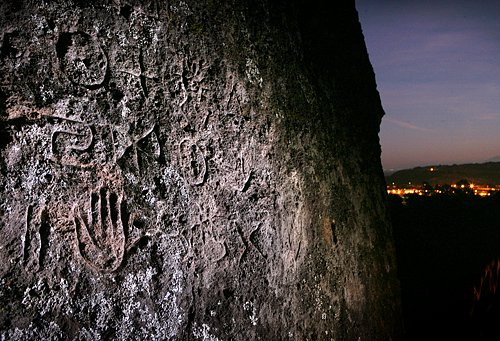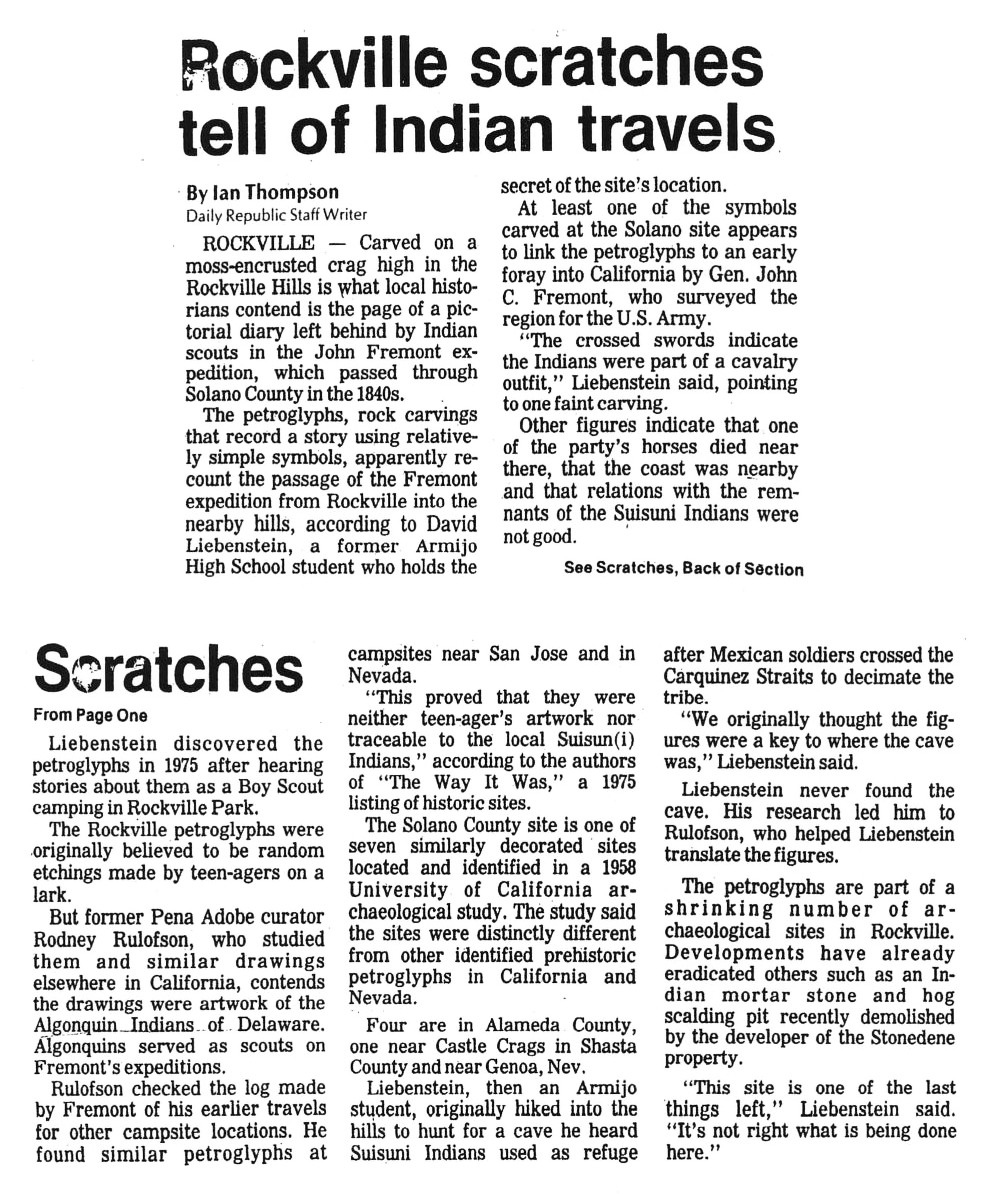

|
Back to Suisun Valley History Archives
Mysterious Petroglyphs May Be Sign of Early Pioneer Explorer

FAIRFIELD — One of the theories about the petroglyphs above Rockville is that they were left behind by bored American Indian members of a party led by The Great Pathfinder, John C. Fremont, as he made his way through the area in the 1840s. Another is that the petroglyphs, defined as carvings on rock, in the cliff face are a pictographic tale of a long-ago battle involving the local Suisuni Indians. "The symbols may tell about a battle they had, but they are now partially destroyed by the mosses and lichen," said local historian and photographer Bob Allen, who had visited them once. "There have been a lot of translations," said historian Jerry Bowen. Rockville area resident Dan Tilley visited them several times and said they have been largely eradicated by people who have done rubbings on them. Rubbings are an impression made by chalk or pencil rubbed on paper placed over the petroglyph. "I have not seen them, but other volunteers have," said Ranger Teri Luchini, who oversees the city of Fairfield's open spaces. "It is off the paths and not available to the public. We have found other things in other parts of the park." The symbols have been a curiosity for residents going back to the early days of Fairfield. Keith Hayes found them in the mid-1950s while walking back from what was then called Mangels Lake. "We came across some petroglyphs on the underside of a large hanging rock," Hayes wrote in an email. "We were kind of excited about it and thought we had made a big discovery, but upon returning to Fairfield, we found out they had been discovered in the 1800s by locals." There are at least seven sites in Nevada, Northern California and Central California with markings that were described as distinctive and not recognized previously in other petroglyph sites in the states, according to a 1958 paper written for the University of California Archaeological Service. One of the sites listed in the paper is located in the area near Rockville. Local historians are convinced that there is at least another site that was discovered in the early 20th century and then lost. Cordelia historian Rodney Rulofson (1901-1975) took an interest in the petroglyphs in the 1950s, examining several of the sites and offering the idea that they were connected to the expeditions of pioneer explorer Fremont. Rulofson is the one who contended the symbols may have been created by the two Algonquian Indians from the eastern United States who Fremont brought with him on his 1843-44 expedition that included crossing through this area. Fremont's maps show that he explored much of the area between Lake Tahoe and the San Francisco Bay, as well as a considerable portion of the Central Valley south of what would later become Sacramento. "Some part of Fremont's trails were near here," Bowen said. Bowen said there may be one other site near Rockville that has petroglyphs, but added it probably is now just as overgrown and harder to find now than the better-known Rockville site. Tilley talked about sites that existed near the top of Rockville Park, "but they have all been marked over and destroyed." Bowen said he is interested in finding the other site, which has not been seen for more than a century. Notes left by Rulofson mentioned a 1954 interview with resident Wynn Mason, who recalled visiting a cave on Soscol Mountain above the Green Valley Gun Club just before World War I. Rulofson wrote, "Located the cave 40 years ago. At that time, he found a large stone at a cave entrance on which someone had carved 'Indian Solano's Cave'." Rulofson also wrote that a forest ranger, who was fighting a wildfire, had paused for a rest in front of a cliff and noticed a draft at his back. An examination uncovered a crack in the rock cliff. "It was a vertical crevice wide enough to permit a man to squeeze in for several feet. The cave continued into the mountain. He saw Indian rock carvings beyond," Rulofson wrote of the ranger's experience on an unknown date. The ranger tried later to guide others to it, but was unable to find it again. The ranger initially thought the carvings may have been made by power crews who built power lines across the mountains, according to Rulofson, but realized, though visible from the cave, it was too distant.
Published January 19, 2012 in the Fairfield Daily Republic
|
The news article below by Ian Thompson was republished in
"Moments in History" in 2003 by the Daily Republic
